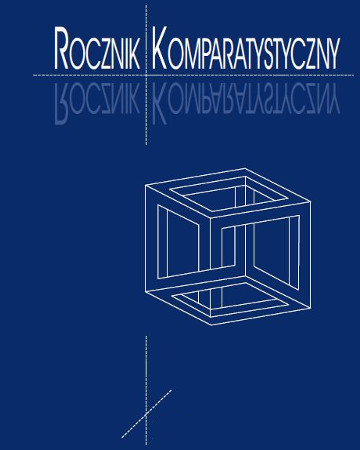





| Autorzy: |
Katarzyna
Kucia
Uniwersytet Jagielloński |
| Słowa kluczowe: | komparatystyka literacka intermedialność związki muzyki z literaturą filozofia oratorium Simone Weil Kaija Saariaho |
| Data publikacji całości: | 2017 |
| Liczba stron: | 31 (231-261) |
| 1. | Barrière, Aleksi. „Théâtre musical, théâtre de la musique. La rencontre de Kaija Saariaho et Peter Sellars”. Tempus Perfectum. Kaija Saariaho: l’ ombre du songe sous la direction de Clément Mao-Takacs 11 (2013): 25–31. |
| 2. | Beyer, Dorothee. Sinn und Genese des Begriffs „Décréation” bei Simone Weil. Altenberge: Oros Verlag, 1992. |
| 3. | Bounoure, Gabriel. „Pierre Reverdy et sa crise religieuse de 1925–27”. Mercure de France 1181 (1962): 192–222. |
| 4. | Biblia w języku greckim. http://www.literatura.hg.pl/greek/php.htm [dostęp: 13.11.2017]. |
| 5. | Biblia Tysiąclecia. Red. ks. Kazimierz Dynarski SAC, Maria Przybył. Poznań: Wydawnictwo Pallottinum, 2012. |
| 6. | Delsol, Chantal. „Simone Weil: L’enracinement d’appartenance et les partis politiques”. Simone Weil. Philosophie, mystique, esthétique. Red. Gizella Gutbrod, Joël Janiaud, Eniko Sepsi. Paris: Harmattan, 2012. 53–63. |
| 7. | Eliot, Thomas Stearns. „Preface”. Simone Weil. The Need for Roots: Prelude to a Declaration of Duties Towards Mankind. Tłum. Arthur Wills. Przedmowa Thomas Stearns Eliot. London: Routledge, 2002. VI–XIII. |
| 8. | Fiori, Gabriella. Simone Weil. Kobieta absolutna. Tłum. Monika Szewc. Poznań: W drodze, 2008. |
| 9. | Freud, Sigmund. „Civilization and its Discontents”. The Freud Reader. Red. Peter Gay. New York: W.W. Norton, 1989. 722–772. |
| 10. | Freund, Richard A. „La tradition mystique juive et Simone Weil”. Cahiers de Simone Weil 10, 3 (1987): 289–296. |
| 11. | Gombrowicz, Witold. Dziennik 1953–1956. Dzieła. T. VIII. Red. Jan Błoński, Kraków–Wrocław: Wydawnictwo Literackie, 1986. |
| 12. | Herbert, George. Wiersze wybrane. Tłum. i posłowie Stanisław Barańczak, Kraków: Znak, 1989. |
| 13. | Kühn, Rolf. „Le Monde comme texte. Perspective herméneutique chez Simone Weil”. Revue de Sciences Philosophiques et Théologique 64 (1980): 509–530. |
| 14. | Little, Janet Patricia. „Simone Weil’s concept of decreation”. Simone Weil’s Philosophy of Culture. Readings Toward a Divine Humanity. Red. i wstęp Richard H. Bell. Cambridge: University Press, 1993. 25–51. |
| 15. | Maalouf, Amin. „La Passion de Simone. Chemin musical en quinze stations. Livret par Amin Maalouf” (książeczka do płyty). Kaija Saariaho, Dawn Upshaw, Finnish Radio Symphony Orchestra, Tapiola Chamber Choir, Esa Pekka-Salonen. La Passion de Simone. Nr katalogowy: ODE 1217-5. Helsinki: Ondine Oy, 2013. 23–34. |
| 16. | McCullough, Lissa. „Grace and Decreation”. The Religious Philosophy of Simone Weil. London: I.B. Tauris, 2014. 171–212. |
| 17. | Nevin, Thomas R. „Waiting, with Vichy, for God”. Simone Weil: Portrait of a Self-Exiled Jew. The University of North Carolina Press, 1991. 260–310. |
| 18. | Pascal, Blaise. Pensées. Tłum. Alban J. Krailsheimer. London: Penguin Books, New York: Penguin Books USA, 1995. |
| 19. | Pétrement, Simone. Simone Weil. A Life. Tłum. Raymond Rosenthal, New York: Schocken Books, 1988. |
| 20. | Rabi, Wladimir. „La conception weilienne de la création: Rencontre avec la Kabbale juive”. Simone Weil: philosophe, historienne et mystique. Red. Gilbert Kahn. Paris: Aubier Montaigne, 1978.141–160. |
| 21. | Rozelle-Stone, A. Rebecca, Stone, Lucian. „Human nature and decreation”. Simone Weil and Theology. London: Bloomsbury, 2013. 67–85. |
| 22. | Rubinkiewicz, Ryszard. „Kenoza w Biblii” [hasło]. Ecyklopedia katolicka. T. 8. Red. Andrzej Szostek, Bogusław Migut, Edward Gigilewicz i in. Lublin: Towarzystwo Naukowe Katolickiego Uniwersytetu Lubelskiego, 2000. 1345–1346. |
| 23. | Saariaho, Kaija. La Passion de Simone for soprano solo, chorus, orchestra. Libretto by Amin Maalouf. London: Chester Music, 2008. |
| 24. | -------. Le passage de frontières. Écrits sur la musique. Textes réunis, présentés et traduits sous la direction de Stéphane Roth. Paris: MF, 2013. |
| 25. | Vetö, Miklos. The Religious Metaphysics of Simone Weil. Tłum. Joan Dargan. Albany: State University of New York Press, 1994. |
| 26. | Weil, Simone. Attente de Dieu. Paris: Éditions Fayard, 1966. |
| 27. | -------. „Dziennik fabryczny”. Zakorzenienie i inne fragmenty. Wybór pism. Tłum. Monika Witkowska. Wybór i przedmowa Andrzej Wielowieyski. Kraków: Znak, 1961. 14–16. |
| 28. | -------. Écrits historiques et politiques. Paris: Gallimard, 1960. |
| 29. | -------. Intuitions pré-chrétiennes. Paris: La Colombe, 1951b. |
| 30. | -------. La condition ouvrière. Paris: Gallimard, 1951a. |
| 31. | -------. La connaissance surnaturelle. Paris: Gallimard, 1950. |
| 32. | -------. La pesanteur et la grâce. Paris: Plon, 1947. |
| 33. | -------. L’enracinement. Prélude à une déclaration des devoirs envers l’être humain. Paris: Gallimard, 1949. |
| 34. | -------. Leçons de philosophie (Roanne 1933–1934). Présentées par Anne Reynaud. Paris: Plon, 1959. |
| 35. | -------. „Nieuporządkowane refleksje o miłości Boga”. Tłum. Jacek Neckar OP. W Drodze 7 (1988): 45–49. |
| 36. | -------. OEuvres. Red. Florence De Lussy. Paris: Gallimard, 1999a. |
| 37. | -------. OEuvres complètes.Cahiers. T. VI, vol. 2. Red. André A. Devaux, Florence de Lussy. Paris: Gallimard, 1997. |
| 38. | -------. OEuvres complètes.Cahiers. T. VI, vol. 3. Red. André A. Devaux, Florence de Lussy. Paris: Gallimard, 2002. |
| 39. | -------. OEuvres complètes. Cahiers. T. VI, vol. 4. Red. André A. Devaux, F. de Lussy. Paris: Gallimard, 2006. |
| 40. | -------. Painovoima ja armo [La Pesanteur et la grâce]. Suomentanut ja johdannolla varustanut Maija Lehtonen. Helsinki: Otava, 1957. |
| 41. | -------. Pensées sans ordre concernant l’amour de Dieu. Paris: Gallimard, 1962. |
| 42. | -------. „Rola w świętym dramacie”. Tłum. Jacek Neckar OP. W Drodze 7 (1990): 43–46. |
| 43. | -------. Świadomość nadprzyrodzona. Wybór myśli. Tłum. Aleksandra Olędzka-Frybesowa. Oprac. Andrzej Wielowieyski. Warszawa: Pax, 1999b. |
| 44. | -------. Wybór pism. Tłum. i oprac. Czesław Miłosz. Kraków: Znak, 1991. |
| 45. | Yourgrau, Palle. Simone Weil. London: Reaktion Books, 2011. |